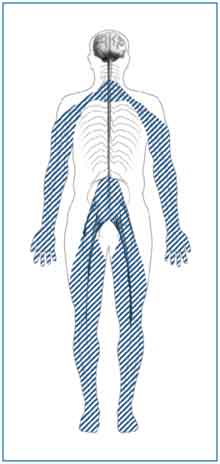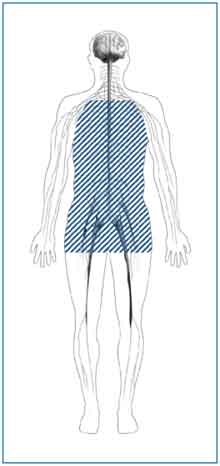- Causes
- Symptoms
- Types of Diabetic Neuropathy
- Neuropathy Affects Nerves Throughout the Body
- Peripheral Neuropathy
- Autonomic Neuropathy
- Proximal Neuropathy
- Focal Neuropathy
- Preventing Diabetic Neuropathy
- Diagnosis
- Treatment
- Points to Remember
- Hope Through Research
Diabetic neuropathies are a family of nerve disorders caused by diabetes. People with diabetes can, over time, have damage to nerves throughout the body. Neuropathies lead to numbness and sometimes pain and weakness in the hands, arms, feet, and legs. Problems may also occur in every organ system, including the digestive tract, heart, and sex organs. People with diabetes can develop nerve problems at any time, but the longer a person has diabetes, the greater the risk.
An estimated 50 percent of those with diabetes have some form of neuropathy, but not all with neuropathy have symptoms. The highest rates of neuropathy are among people who have had the disease for at least 25 years.
Diabetic neuropathy also appears to be more common in people who have had problems controlling their blood glucose levels, in those with high levels of blood fat and blood pressure, in overweight people, and in people over the age of 40. The most common type is peripheral neuropathy, also called distal symmetric neuropathy, which affects the arms and legs.
[Top]Causes
The causes are probably different for different varieties of diabetic neuropathy. Researchers are studying the effect of glucose on nerves to find out exactly how prolonged exposure to high glucose causes neuropathy. Nerve damage is likely due to a combination of factors:
- metabolic factors, such as high blood glucose, long duration of diabetes, possibly low levels of insulin, and abnormal blood fat levels
- neurovascular factors, leading to damage to the blood vessels that carry oxygen and nutrients to the nerves
- autoimmune factors that cause inflammation in nerves
- mechanical injury to nerves, such as carpal tunnel syndrome
- inherited traits that increase susceptibility to nerve disease
- lifestyle factors such as smoking or alcohol use
Symptoms
Symptoms depend on the type of neuropathy and which nerves are affected. Some people have no symptoms at all. For others, numbness, tingling, or pain in the feet is often the first sign. A person can experience both pain and numbness. Often, symptoms are minor at first, and since most nerve damage occurs over several years, mild cases may go unnoticed for a long time. Symptoms may involve the sensory or motor nervous system, as well as the involuntary (autonomic) nervous system. In some people, mainly those with focal neuropathy, the onset of pain may be sudden and severe.
Symptoms may include
- numbness, tingling, or pain in the toes, feet, legs, hands, arms, and fingers
- wasting of the muscles of the feet or hands
- indigestion, nausea, or vomiting
- diarrhea or constipation
- dizziness or faintness due to a drop in postural blood pressure
- problems with urination
- erectile dysfunction (impotence) or vaginal dryness
- weakness
In addition, the following symptoms are not due to neuropathy but nevertheless often accompany it:
- weight loss
- depression
Types of Diabetic Neuropathy
Diabetic neuropathies can be classified as peripheral, autonomic, proximal, and focal. Each affects different parts of the body in different ways.
- Peripheral neuropathy causes either pain or loss of feeling in the toes, feet, legs, hands, and arms.
- Autonomic neuropathy causes changes in digestion, bowel and bladder function, sexual response, and perspiration. It can also affect the nerves that serve the heart and control blood pressure. Autonomic neuropathy can also cause hypoglycemia (low blood sugar) unawareness, a condition in which people no longer experience the warning signs of hypoglycemia.
- Proximal neuropathy causes pain in the thighs, hips, or buttocks and leads to weakness in the legs
- Focal neuropathy results in the sudden weakness of one nerve, or a group of nerves, causing muscle weakness or pain. Any nerve in the body may be affected.
Neuropathy Affects Nerves Throughout the Body
Peripheral Neuropathy
- toes
- feet
- legs
- hands
- arms
Autonomic Neuropathy
- heart and blood vessels
- digestive system
- urinary tract
- sex organs
- sweat glands
- eyes
Proximal Neuropathy
- thighs
- hips
- buttocks
Focal Neuropathy
- eyes
- facial muscles
- ears
- pelvis and lower back
- thighs
- abdomen
Peripheral Neuropathy
This type of neuropathy damages nerves in the arms and legs. The feet and legs are likely to be affected before the hands and arms. Many people with diabetes have signs of neuropathy upon examination but have no symptoms at all. Symptoms of peripheral neuropathy may include
These symptoms are often worse at night. Peripheral neuropathy may also cause muscle weakness and loss of reflexes, especially at the ankle, leading to changes in gait (walking). Foot deformities, such as hammertoes and the collapse of the midfoot, may occur. Blisters and sores may appear on numb areas of the foot because pressure or injury goes unnoticed. If foot injuries are not treated promptly, the infection may spread to the bone, and the foot may then have to be amputated. Some experts estimate that half of all such amputations are preventable if minor problems are caught and treated in time. |  Peripheral neuropathy affects the nerves in your arms, hands, legs, and feet. |
Autonomic Neuropathy
Autonomic neuropathy affects the nerves that control the heart, regulate blood pressure, and control blood glucose levels. It also affects other internal organs, causing problems with digestion, respiratory function, urination, sexual response, and vision. In addition, the system that restores blood glucose levels to normal after a hypoglycemic episode may be affected, resulting in loss of the warning signs of hypoglycemia such as sweating and palpitations. Unawareness of Hypoglycemia Normally, symptoms such as shakiness occur as blood glucose levels drop below 70 mg/dL. In people with autonomic neuropathy, symptoms may not occur, making hypoglycemia difficult to recognize. However, other problems can also cause hypoglycemia unawareness so this does not always indicate nerve damage. Heart and Circulatory System The heart and circulatory system are part of the cardiovascular system, which controls blood circulation. Damage to nerves in the cardiovascular system interferes with the body's ability to adjust blood pressure and heart rate. As a result, blood pressure may drop sharply after sitting or standing, causing a person to feel light-headed--or even to faint. Damage to the nerves that control heart rate can mean that it stays high, instead of rising and falling in response to normal body functions and exercise. |  Autonomic neuropathy affects the nerves in your lungs, heart, stomach, intestines, bladder, and sex organs. |
Digestive System
Nerve damage to the digestive system most commonly causes constipation. Damage can also cause the stomach to empty too slowly, a condition called gastroparesis. Severe gastroparesis can lead to persistent nausea and vomiting, bloating, and loss of appetite. Gastroparesis can make blood glucose levels fluctuate widely as well, due to abnormal food digestion.
Nerve damage to the esophagus may make swallowing difficult, while nerve damage to the bowels can cause constipation alternating with frequent, uncontrolled diarrhea, especially at night. Problems with the digestive system may lead to weight loss.
Urinary Tract and Sex Organs
Autonomic neuropathy most often affects the organs that control urination and sexual function. Nerve damage can prevent the bladder from emptying completely, allowing bacteria to grow in the bladder and kidneys and causing urinary tract infections. When the nerves of the bladder are damaged, urinary incontinence may result because a person may not be able to sense when the bladder is full or control the muscles that release urine.
Neuropathy can also gradually decrease sexual response in men and women, although the sex drive is unchanged. A man may be unable to have erections or may reach sexual climax without ejaculating normally. A woman may have difficulty with lubrication, arousal, or orgasm.
Sweat Glands
Autonomic neuropathy can affect the nerves that control sweating. When nerve damage prevents the sweat glands from working properly, the body cannot regulate its temperature properly. Nerve damage can also cause profuse sweating at night or while eating.
Eyes
Finally, autonomic neuropathy can affect the pupils of the eyes, making them less responsive to changes in light. As a result, a person may not be able to see well when the light is turned on in a dark room or may have trouble driving at night.
[Top]Proximal Neuropathy
Proximal neuropathy, sometimes called lumbosacral plexus neuropathy, femoral neuropathy, or diabetic amyotrophy, starts with pain in either the thighs, hips, buttocks, or legs, usually on one side of the body. This type of neuropathy is more common in those with type 2 diabetes and in older people. It causes weakness in the legs, manifested by an inability to go from a sitting to a standing position without help. Treatment for weakness or pain is usually needed. The length of the recovery period varies, depending on the type of nerve damage.
[Top]Focal Neuropathy
Occasionally, diabetic neuropathy appears suddenly and affects specific nerves, most often in the head, torso, or leg. Focal neuropathy may cause
- inability to focus the eye
- double vision
- aching behind one eye
- paralysis on one side of the face (Bell's palsy)
- severe pain in the lower back or pelvis
- pain in the front of a thigh
- pain in the chest, stomach, or flank
- pain on the outside of the shin or inside the foot
- chest or abdominal pain that is sometimes mistaken for heart disease, heart attack, or appendicitis
Focal neuropathy is painful and unpredictable and occurs most often in older people. However, it tends to improve by itself over weeks or months and does not cause long-term damage.
People with diabetes also tend to develop nerve compressions, also called entrapment syndromes. One of the most common is carpal tunnel syndrome, which causes numbness and tingling of the hand and sometimes muscle weakness or pain. Other nerves susceptible to entrapment may cause pain on the outside of the shin or the inside of the foot.
[Top]Preventing Diabetic Neuropathy
The best way to prevent neuropathy is to keep your blood glucose levels as close to the normal range as possible. Maintaining safe blood glucose levels protects nerves throughout your body.
For additional information on preventing diabetes complications, including neuropathy, visit Diabetes 101 or request the "Prevent Diabetes Problems" series from the National Diabetes Information Clearinghouse at 1-800-860-8747.
Diagnosis
Neuropathy is diagnosed on the basis of symptoms and a physical exam. During the exam, the doctor may check blood pressure and heart rate, muscle strength, reflexes, and sensitivity to position, vibration, temperature, or a light touch.
The doctor may also do other tests to help determine the type and extent of nerve damage.
- A comprehensive foot exam assesses skin, circulation, and sensation. The test can be done during a routine office visit. To assess protective sensation or feeling in the foot, a nylon monofilament (similar to a bristle on a hairbrush) attached to a wand is used to touch the foot. Those who cannot sense pressure from the monofilament have lost protective sensation and are at risk for developing foot sores that may not heal properly. Other tests include checking reflexes and assessing vibration perception, which is more sensitive than touch pressure.
- Nerve conduction studies check the transmission of electrical current through a nerve. With this test, an image of the nerve conducting an electrical signal is projected onto a screen. Nerve impulses that seem slower or weaker than usual indicate possible damage. This test allows the doctor to assess the condition of all the nerves in the arms and legs.
- Electromyography (EMG) shows how well muscles respond to electrical signals transmitted by nearby nerves. The electrical activity of the muscle is displayed on a screen. A response that is slower or weaker than usual suggests damage to the nerve or muscle. This test is often done at the same time as nerve conduction studies.
- Quantitative sensory testing (QST) uses the response to stimuli, such as pressure, vibration, and temperature, to check for neuropathy. QST is increasingly used to recognize sensation loss and excessive irritability of nerves.
- A check of heart rate variability shows how the heart responds to deep breathing and to changes in blood pressure and posture.
- Ultrasound uses sound waves to produce an image of internal organs. An ultrasound of the bladder and other parts of the urinary tract, for example, can show how these organs preserve a normal structure and whether the bladder empties completely after urination.
- Nerve or skin biopsy involves removing a sample of nerve or skin tissue for examination by microscope. This test is most often used in research settings.
Treatment
The first step is to bring blood glucose levels within the normal range to prevent further nerve damage. Blood glucose monitoring, meal planning, exercise, and oral drugs or insulin injections are needed to control blood glucose levels. Although symptoms may get worse when blood glucose is first brought under control, over time, maintaining lower blood glucose levels helps lessen neuropathic symptoms. Importantly, good blood glucose control may also help prevent or delay the onset of further problems.
Additional treatment depends on the type of nerve problem and symptom, as described in the following sections.
[Top]Foot Care
People with neuropathy need to take special care of their feet. The nerves to the feet are the longest in the body and are the ones most often affected by neuropathy. Loss of sensation in the feet means that sores or injuries may not be noticed and may become ulcerated or infected. Circulation problems also increase the risk of foot ulcers.
More than half of all lower limb amputations in the United States occur in people with diabetes--86,000 amputations per year. Doctors estimate that nearly half of the amputations caused by neuropathy and poor circulation could have been prevented by careful foot care. Here are the steps to follow:
- Clean your feet daily, using warm--not hot--water and a mild soap. Avoid soaking your feet. Dry them with a soft towel; dry carefully between your toes.
- Inspect your feet and toes every day for cuts, blisters, redness, swelling, calluses, or other problems. Use a mirror (laying a mirror on the floor works well) or get help from someone else if you cannot see the bottoms of your feet. Notify your health care provider of any problems.
- Moisturize your feet with lotion, but avoid getting it between your toes.
- After a bath or shower, file corns and calluses gently with a pumice stone.
- Each week or when needed, cut your toenails to the shape of your toes and file the edges with an emery board.
- Always wear shoes or slippers to protect your feet from injuries. Prevent skin irritation by wearing thick, soft, seamless socks.
- Wear shoes that fit well and allow your toes to move. Break in new shoes gradually by wearing them for only an hour at a time at first.
- Before putting your shoes on, look them over carefully and feel the insides with your hand to make sure they have no tears, sharp edges, or objects in them that might injure your feet.
- If you need help taking care of your feet, make an appointment to see a foot doctor, also called a podiatrist.
For additional information on foot care, contact the National Diabetes Information Clearinghouse at 1-800-860-8747. Information is also available at: Foot Related Diabetes Complications.
Pain Relief
To relieve pain, burning, tingling, or numbness, the doctor may suggest aspirin, acetaminophen, or nonsteroidal anti-inflammatory drugs (NSAIDs) such as ibuprofen. (People with renal disease should use NSAIDs only under a doctor's supervision.) A topical cream called capsaicin is another option. Tricyclic antidepressant medications such as amitriptyline, imipramine, and nortriptyline, or anticonvulsant medications such as carbamazepine or gabapentin may relieve pain in some people. Codeine may be prescribed for a short time to relieve severe pain. Also, mexiletine, used to regulate heartbeat, has been effective in treating pain in several clinical trials.
Other pain treatments include transcutaneous electronic nerve stimulation (TENS), which uses small amounts of electricity to block pain signals, as well as hypnosis, relaxation training, biofeedback, and acupuncture. Walking regularly or using elastic stockings may also help leg pain.
Gastrointestinal Problems
To relieve mild symptoms of gastroparesis--indigestion, belching, nausea, or vomiting--doctors suggest eating small, frequent meals, avoiding fats, and eating less fiber. When symptoms are severe, the doctor may prescribe erythromycin to speed digestion, metoclopramide to speed digestion and help relieve nausea, or other drugs to help regulate digestion or reduce stomach acid secretion.
To relieve diarrhea or other bowel problems, the doctor may prescribe an antibiotic such as tetracycline, or other medications as appropriate.
Dizziness and Weakness
Sitting or standing slowly may help prevent the light-headedness, dizziness, or fainting associated with blood pressure and circulation problems. Raising the head of the bed or wearing elastic stockings may also help. Some people may benefit from increased salt in the diet and treatment with salt-retaining hormones. Others may benefit from high blood pressure medications. Physical therapy can help when muscle weakness or loss of coordination is a problem.
Urinary and Sexual Problems
To clear up a urinary tract infection, the doctor will probably prescribe an antibiotic. Drinking plenty of fluids will help prevent another infection. People who have incontinence should try to urinate at regular intervals (every 3 hours, for example) since they may not be able to tell when their bladder is full.
To treat erectile dysfunction in men, the doctor will first do tests to rule out a hormonal cause. Several methods are available to treat erectile dysfunction caused by neuropathy, including taking oral drugs, using a mechanical vacuum device, or injecting a drug called a vasodilator into the penis before sex. The vacuum and vasodilator raise blood flow to the penis, making it easier to have and maintain an erection. Another option is to surgically implant an inflatable or semirigid device in the penis. A constriction ring or penile sling may be helpful.
Vaginal lubricants may be useful for women when neuropathy causes vaginal dryness. To treat problems with arousal and orgasm, the doctor may refer the woman to a gynecologist.
[Top]Points to Remember
- Diabetic neuropathies are nerve disorders caused by many of the abnormalities common to diabetes, such as high blood glucose.
- Neuropathy can affect nerves throughout the body, causing numbness and sometimes pain in the hands, arms, feet, or legs, and problems with the digestive tract, heart, and sex organs.
- Treatment first involves bringing blood glucose levels within the normal range. Good blood glucose control may help prevent or delay the onset of further problems.
- Foot care is another important part of treatment. People with neuropathy need to inspect their feet daily for any injuries. Untreated injuries increase the risk of infected foot sores and amputation.
- Treatment also includes pain relief and other medications as needed, depending on the type of nerve damage.
- Smoking significantly increases the risk of foot problems and amputation. If you smoke, ask your health care provider for help in quitting.
Hope Through Research
The National Institute of Diabetes and Digestive and Kidney Diseases (NIDDK) and the National Institute of Neurological Disorders and Stroke (NINDS) conduct and support research to help people with diabetes, including studies related to diabetic neuropathy. A complete listing of clinical research studies can be found at http://ClinicalTrials.gov.
This article was reviewed by Peter J. Dyck, M.D., Peripheral Neuropathy Research Center, Mayo Clinic Rochester, Rochester, MN; Eva L. Feldman, M.D., Ph.D., Department of Neurology, University of Michigan, Ann Arbor, MI; and Aaron I. Vinik, M.D., The Diabetes Research Institute, Eastern Virginia Medical School, Norfolk, VA. NIH Publication No. 02-3185; May 2002
NIDDK









